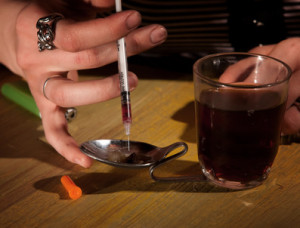A few days ago, Cory Monteith, a rising star in television, died from the deadly combination of alcohol and heroin. Monteith is not the first person to die from an addiction to alcohol or drugs, and sadly, he won’t be the last. In this post, I’ll be talking about why alcohol and heroin are so lethal when taken together.
Why alcohol and opiates are such a deadly mix
Both alcohol and heroin (an opiate) are depressant drugs, or what some call “downers.” They are called this because of the physiological effects it has on the nervous system: They depress, or slow down, the functioning of all internal organs. Depressants slow down your breathing, heart rate, motor functioning – everything.
Alcohol may at first seem like an “upper,” because some people lose their inhibitions and become excited after only a couple of drinks. The truth is, even a small amount slows down the central nervous system. Basically, the more alcohol you drink, the slower your functioning. Speech is slurred, motor coordination is poorer, and over time, the drinker can barely keep their eyes open. Too much alcohol over a short period of time can lead to poisoning, coma, or death.
Opiates or opioids are another powerful class of depressants that come from the opium poppy plant. They can be natural or semisynthetic. Users take these drugs to minimize physical or emotional pain, to prevent withdrawal symptoms, or to experience its euphoric effects. Examples of opiate drugs (natural or semisynthetic) include heroin, morphine, codeine, Vicodin, and OxyContin (or oxycodone).
Alcohol and Opiates are Synergistic
Have you ever heard the expression, “the sum is greater than its parts”? What this phrase means is that the outcome of something is often much greater than just adding the two parts together. For example, imagine holding a lit match in one hand and a tablespoon of gasoline in the other hand. Individually, by themselves, these two objects can burn and irritate the skin. But, when you light the gasoline with the flame – when you combine the two – the effects are more powerful than by themselves.
In pharmacology, this is the principle of synergy: the reaction of two depressants is much greater than the sum of the effects if taken by themselves.
“I took my little medication (Valium) with me one night, drinking in the bar. I played some pool and that’s all I remember. This was on a Sunday. When I woke up, it was Wednesday.” Recovering polydrug abuser (Inaba and Cohen, pg. 171)
When a person drinks alcohol and takes another depressant (like heroin or Valium), the liver is too busy metabolizing the alcohol to do anything about the other depressant. This means the narcotic passes through the system, without being metabolized or broken down into smaller, less powerful doses. The synergistic effects of these drugs exaggerates respiratory depression; everything slows down at a much greater intensity than taking one drug by itself.
“I’d be waiting and waiting and during the time that I was waiting, I’d be getting drunk. By the time I got around to doing my shot, I was already drunk. I’d hit up and boom, I’d be on the floor.” 36-year-old male heroin user in treatment (pg. 154)
Alcohol, drugs, and overdoses
The truth is, most overdoses are accidental. Rarely do addicts take drugs with the intention of killing themselves. It’s likely that Cory Monteith had no idea how strong (i.e., pure) the heroin was, or just how intoxicated he was from the alcohol. The combination of these two drugs, though, was enough to completely stop his breathing and heart.
Hoping this bit of psycho-pharmacology increases your understanding of alcohol and drugs…
Links related to this post:
- Inaba and Cohen (2007). Uppers, Downers, and All Arounders: Physical and mental effects of psychoactive drugs (Fifth Edition).
- Click here to read my previous post on the addictive properties of crack cocaine
- Click here to read post on how addiction is more than just ‘choice’
- Click here for an alcohol ‘reality check’


